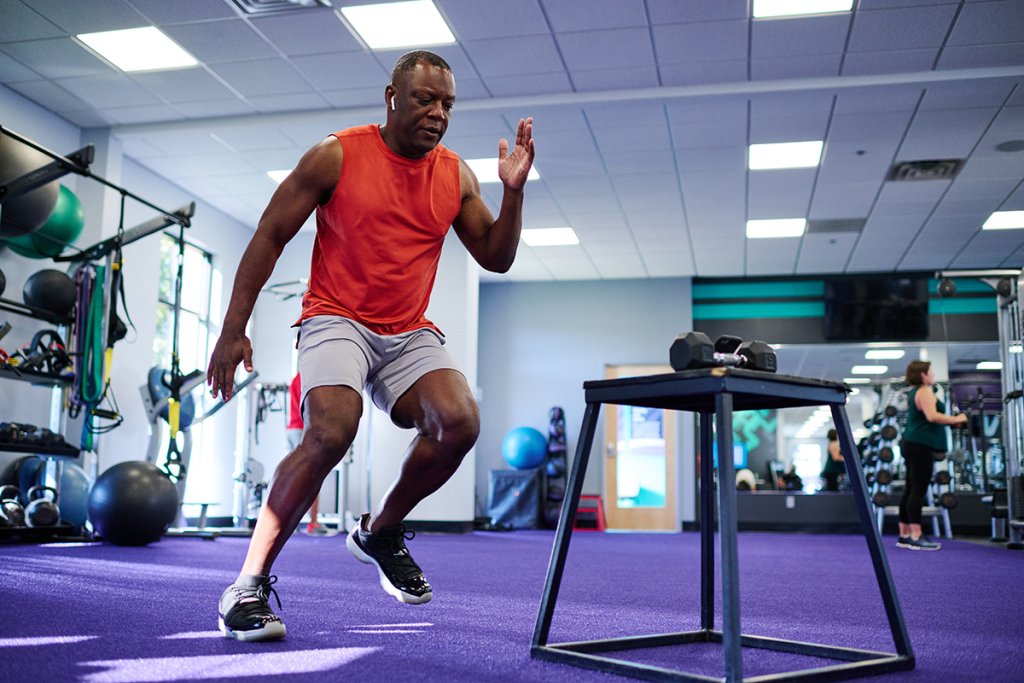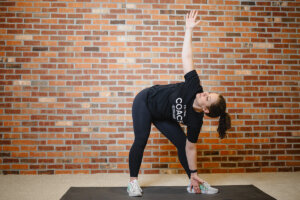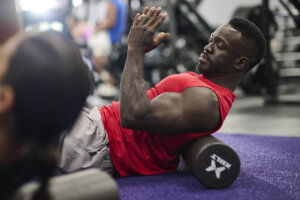Why do we love high-intensity interval training, or HIIT workouts? They’re fast, effective ways to get a great workout in a short period of time, whether your goal is weight loss, muscle gain, or overall fitness.
You can build your own HIIT workout plan for muscle gain and fat loss by considering just a few factors. Let’s get into it!
What is HIIT?
High intensity interval training involves alternating your workout between high-intensity and low-intensity movements. A HIIT workout takes a shorter amount of time than other muscle-building workout routines and requires less rest, because most HIIT workouts use lighter weights or bodyweight exercises. If you’re looking to build muscle but don’t have the time for a full strength training session, HIIT is an especially effective exercise option.
How are HIIT workout exercises different from cardio?
While HIIT and cardio can both get your heart pounding, there are some differences that might affect how you approach them.
Level of intensity
One of the biggest differences between HIIT workout exercises and cardio is the level of intensity in shorter bursts. The high-intensity exercises that make up a HIIT workout require your muscles to work at maximum effort.
When you’re doing steady-state cardio, you likely aren’t working out at that same intensity. That’s not to say you’re not giving it your all! But if you know that your workout for the day is a 3-mile run, you’re probably not going to start at a sprinter’s pace. Instead, you’ll pace yourself at a moderate rate of activity so that you can finish your workout.
Aerobic vs. anaerobic exercise
With steady-state cardio, you’re keeping your heart rate fairly consistent throughout your entire workout. This is called aerobic exercise, which means “with oxygen.” Your lungs and heart are working harder to fuel your body with oxygen.
Aerobic exercise definitely requires you to work hard, but you’re giving your absolute maximum effort during a high-intensity interval training workout. That’s why HIIT is fueled differently. It’s classified as anaerobic exercise, which means “without oxygen.” This means your body is breaking down other stored energy sources like fat and glucose to fuel your workout, because you need immediate and readily available energy. That’s what makes HIIT so great for burning fat!
Recovery periods
Another thing that differentiates HIIT from cardio is the recovery periods. Typically lasting between 10 seconds and 30 seconds, recovery periods allow you a short amount of time to bring your heart rate down — before pumping it back up again with hard work.
Of course, you can take breaks during steady-state cardio, but HIIT makes those breaks, since you have just a few timed seconds, a lot more dramatic. By strengthening your heart and lungs, HIIT can help improve your VO2 max — the maximum amount of oxygen you can use during exercise. VO2 max is a great measure of your endurance, and it can be used as a baseline for one’s cardiovascular fitness. Calculating your VO2 max requires specific equipment and testing, and while it can help you increase the efficiency of your exercise, it is not necessary to know your VO2 max. Just know that when you’re doing HIIT, even if it’s a short workout, you’re improving it!
The importance of having a muscle-building workout routine
Interval training encourages the development of lean body mass, which is required for a healthy metabolism. Muscle-building routines enhance your bone density, boost metabolism, and improve overall bodily functions.
Strength training lays the foundation for a stronger, more capable you. Whether it’s lifting heavier, performing better, or simply feeling your best in everyday life, a strategic muscle-building routine is important to any overall workout plan.
How HIIT workouts help with building muscle
The best part of incorporating HIIT into your muscle-building workout routine actually happens after your workout. HIIT raises your resting metabolic rate for around 24 hours after you’ve finished your workout.
This occurs because biologically, we are meant to move two ways: aerobically (traveling long distance on foot) and anaerobically (like sprinting away from danger). Anaerobic training, like HIIT, recruits fat for fuel, promoting a leaner body composition, in addition to stronger muscles, heart health, and improved speed and power.
The dynamic duo: Strength training and fat burn
Because you can incorporate strength-training moves (like push-ups, squats, and deadlifts) into your HIIT routine, along with other more aerobic exercises that get your heart pumping (like high knees, skaters, and jumping), HIIT is a great muscle-building workout routine that also burns fat. There are a lot of powerful training moves that work your entire body and use full muscle groups, particularly your legs and core.
Depending on your goals, you may want to balance your strength training with cardio. If your goal is building muscle and mass gain, we suggest you focus primarily on weight training and save cardio as a secondary focus.
Word of caution: Heavier weights and HIIT
If you’re doing heavy weight training or powerlifting, it might be more difficult to incorporate that level of weight into a HIIT routine. The goal of HIIT workouts is to complete as many reps as possible during your limited seconds of work. If you are squatting or deadlifting with a challenging amount of weight, it can be really difficult to get multiple reps in during a circuit, no matter how strong your legs are!
Coach tip: We recommend saving the heavy-weight training for leg day and using lighter weights or just your bodyweight for HIIT workouts at the gym or at home.
The importance of proper form
With lighter weights, proper form is still just as important. Make sure you’re using your core, keeping your body in a straight line and keeping your right foot in line with your left. If you’re doing a one-sided move like lunges, make sure that you stay on one side (for example, starting with your right foot) for the first round. HIIT work intervals are only seconds long, not minutes, so you can get a more efficient leg workout if you’re not taking the time to switch from your left to right foot.
Doing such hard work for less time is what makes high-intensity interval training so effective. Even if you’re used to working out with heavy weights, you’ll be in a good place to see results from HIIT within weeks!
How to build your own HIIT workout plan for muscle gain: 5 steps
The best HIIT workout plan for the gym or at home will depend on your personal preferences. You might prefer trying HIIT on a cardio machine, like a treadmill or a bike, or you might prefer doing HIIT workouts with bodyweight moves. You might also have your own preferences for the length of your rest periods and work intervals. Some people prefer equal seconds of work and rest, while others might prefer 20 seconds of work to only 10 seconds of rest (a common format known as Tabata).
There’s plenty of content out there that can help you build a HIIT workout, or suggest exercises for you to include. Regardless of what composes your best HIIT workout routine, we collected some of the most important information you’ll need in order to build a routine that gives you the most benefits of HIIT.
When you build any workout plan, there are a few things to keep in mind. We’ll dig into all five of these throughout the blog:
- HIIT workout exercises: The HIIT workout exercises that should be the backbone of your plan
- Structure: Warm-up and cooldown, sets, reps, and rest periods
- Schedule and frequency: How many days a week to do a HIIT workout, and how long the workouts could be
- Rest and recovery: The importance of rest days, and how many to incorporate
- Adjustments: Taking stock of what’s working — and making adjustments to keep progress moving forward
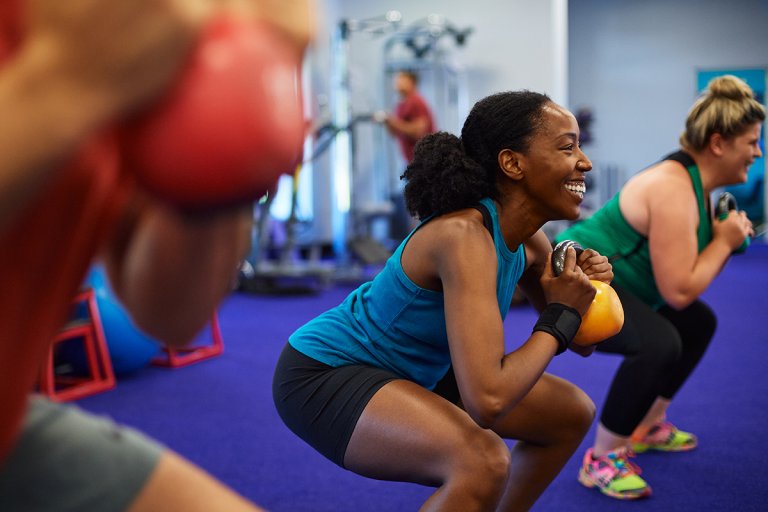
When it comes to a HIIT workout plan for muscle gain and fat burn, it’s about more than just doing a random assortment of HIIT workouts at the gym. As we mentioned above, you’ll want to combine strength-training exercises with moves that get your heart rate up.
Make sure to incorporate resistance training using compound movements like push-ups, pull-ups, squats, and kettlebell swings. You’ll get more bang for your buck as these recruit a variety of muscles and burn the most calories. Movements that utilize your leg muscles and core, like squats and burpees, are especially great because your legs contain larger muscle groups.
The following exercises can form the pillars of your training, but of course, feel free to mix it up every so often.
HIIT workout exercises: Strength-training
- Squats
- Push-Ups
- Lunges
- Kettlebell Swing
- Straight Arm Pulldown
- Bench Press
- Bent-Over Row
HIIT workout exercises: Aerobic
- Jump Squats
- Burpees
- High Knees
- Mountain Climbers
Coach Tip for HIIT
If you plan on doing HIIT on a day you also lift weights, do it at the end of your workout to maximize that fat-burning window. This will also allow you to maintain high energy and good form while lifting.
2. Workout routine structure: Reps, intervals, and rest
Your HIIT routine should begin with a dynamic warm-up to prepare your muscles for the exertion ahead. At the end of your workout, a cooldown phase is essential to usher your body into a state of recovery with reduced injury risks.
Then, map out your workout structure. Incorporate sets consisting of short, high-intensity intervals juxtaposed with rest or low-intensity periods.
High intensity means high for you. HIIT is meant to push you past your anaerobic threshold, but everyone has to start somewhere. As you near your threshold, you will be out of breath and unable to carry on a conversation. Your muscles and lungs may feel uncomfortable, but that’s OK. It’s working! If you’re new or concerned, just “touch” on that feeling as opposed to maxing out every time to reap the benefits of regular interval training. Then push yourself more toward HIIT.
Intervals and rest periods
For each interval, you will push yourself really hard for 20 seconds of work and then completely recover for 10 seconds. Then you’ll repeat this for a set number of times. You may adjust your recovery and work times depending on your exercise goals and fitness level.
During the high-intensity pushes, it’s important to get to it right away. For example, if you’re on the treadmill, be on the verge of uncomfortable before the buzzer sounds and quickly increase the pace or the incline (or both). Then, when you recover, move to the treadmill rails (off the belt) and breathe. You may not fully recover as the intervals progress during the set, but that’s the point. Your body will respond to the increased discomfort.
Tip: Download the AF App to access HIIT workouts with a built-in timer, or add your own custom workout.
Sets and reps
Reps (the number of times you perform an exercise) and sets (a group of reps) are where the details of your workout routine start to take shape.
For this muscle-building workout plan, we suggest you repeat your 30-second sets around 8 times before rewarding yourself with a big break!
3. Building a workout plan’s schedule and frequency
How often should you engage in HIIT? For optimal muscle gain, try integrating 1–2 HIIT sessions weekly, each lasting 25–30 minutes. Ensure you have rest or active recovery days in between to give your muscles time to recover and grow. After all, balance is key; overtraining can sabotage muscle recovery and growth.
4. Rest and recovery days
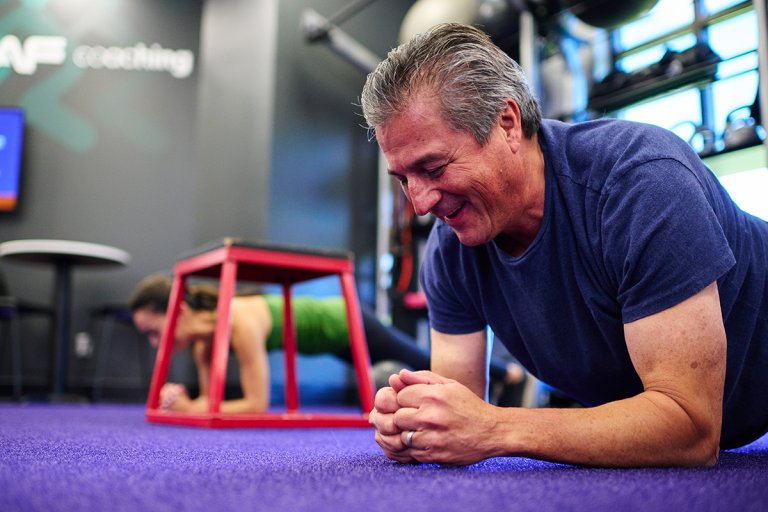
Rest days are an important part of your overall workout plan for muscle gain. It’s during the recovery phase that your muscles repair and grow. Not to mention, overtraining can lead to injury and hinder the great progress you’re making.
Rest days
When you build a workout plan, consider having one full rest day a week, and listen to your body for signs of fatigue or overtraining. This is where you rest from high-impact activity and opt for low-impact or active recovery instead.
Active recovery days
You can also incorporate active recovery workouts when you build a workout plan, which use low-intensity exercises to help your body release tension and decrease muscle soreness.
5. Muscle-building workout routine adjustments
Stay tuned in to your body’s feedback. If plateaus hit, reassess and tweak your program — adjust exercises, intensity, rest periods, or frequency. Progression is not linear; it thrives on change and adaptation!
Here’s the secret to making a HIIT workout plan that actually works
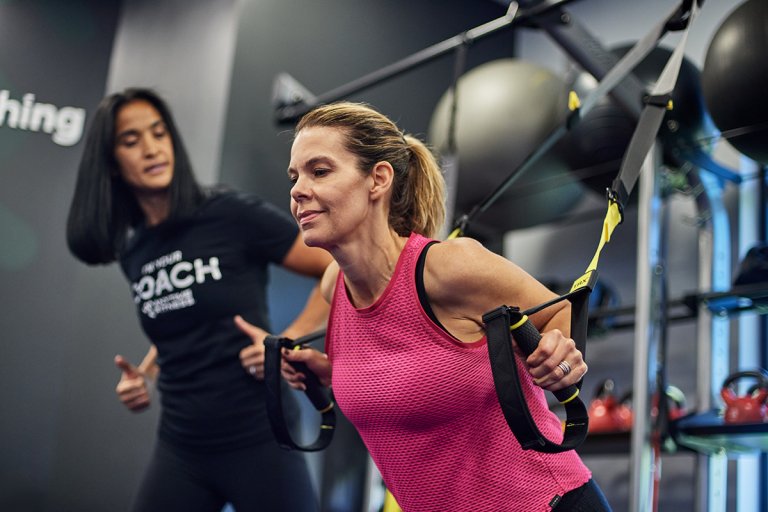
Every body is unique, and the road to muscle growth is no one-size-fits-all venture. Personalized coaching offers a custom-tailored HIIT workout plan for the gym or at home that aligns with your body type, goals, and lifestyle. With guidance tailored to your needs, you can maximize your gains and minimize the risk of injury. Like a skilled architect drawing up blueprints, a good coach constructs a workout regime that’s exclusively yours.
Personal coaches offer so many benefits, including:
- Effective workouts that are personalized to your specific goals
- Accountability and motivation on days when you might need a little boost
- Long-term knowledge that you can use for years to come
- Guidance both in and out of the gym
- Lower risk of injury
A final word on how to build a HIIT workout plan for muscle gain
Knowing how to create a HIIT workout plan for the gym or at home is as much an art as it is a science. The most effective workout plan is the one that takes into account your individual goals, body composition, and lifestyle. It should evolve as you do, continually challenging you and promoting steady progress.
Remember, while guides like this provide structure, there’s no one-size-fits-all approach for how to create a workout plan. If you’re in doubt, seeking the advice of a qualified personal trainer can provide invaluable support.
3 HIIT workouts at the gym
- 25-Minute HIIT Bike Workout: Get Fitter Faster
- Burn Calories in a Flash: HIIT Treadmill Workout
- Heart-Pumping Elliptical HIIT Workout For All Levels
If your goal is muscle mass gain and physical longevity, talk to a Coach about getting a body composition scan at your Anytime Fitness gym. Find the Anytime Fitness gym location nearest you for a FREE fitness consultation.
